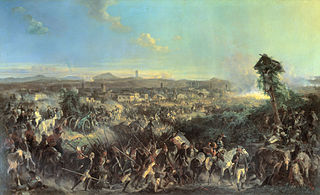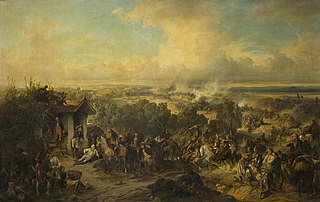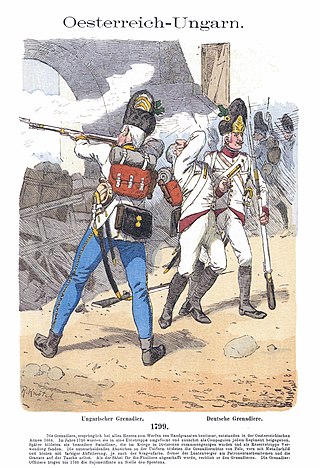
The Battle of Novi saw a combined army of the Habsburg monarchy and Imperial Russians under Field Marshal Alexander Suvorov attack a Republican French army under General Barthélemy Catherine Joubert. As soon as Joubert fell during the battle, Jean Victor Marie Moreau immediately took overall command of the French forces. After a prolonged and bloody struggle, the Austro-Russians broke through the French defenses and drove their enemies into a disorderly retreat, while French division commanders Catherine-Dominique de Pérignon and Emmanuel Grouchy were captured. Novi Ligure is in the province of Piedmont in Northern Italy a distance of 58 kilometres (36 mi) north of Genoa. The battle occurred during the War of the Second Coalition which was part of the French Revolutionary Wars.

The Battle of (the) Trebbia was fought near the rivers of Tidone, Trebbia, and Nure in northern Italy between the joint Russian and Habsburg army under Alexander Suvorov and the Republican French army of Étienne-Jacques-Joseph-Alexandre Macdonald. Though the opposing armies were approximately equal in total numbers, the Austro-Russians severely defeated the French, sustaining about 5,500 casualties while inflicting losses of 16,500 on their enemies. The War of the Second Coalition engagement occurred west of Piacenza, a city located 70 kilometres (43 mi) southeast of Milan.

Étienne Jacques-Joseph-Alexandre Macdonald, 1st duc de Tarente, was a Marshal of the Empire and military leader during the French Revolutionary and Napoleonic Wars.

Count Alexander Vasilyevich Suvorov-Rymniksky, Prince of Italy, was a Russian general and military theorist in service of the Russian Empire and the Habsburg monarchy. He was Count of Rymnik (1789), Graf of the Holy Roman Empire (1789), Feldmarschall of the Holy Roman Empire (1799), Prince of the Kingdom of Sardinia (1799), Grand marshal of the Kingdom of Sardinia (1799), Prince or Knyaz of the Russian Empire (1799), Field marshal (1794) and the last Generalissimo (1799) of the Russian Empire. Suvorov is considered one of the greatest military commanders in Russian history and one of the great generals of the early modern period. He was awarded numerous medals, titles, and honors by Russia, as well as by other countries. Suvorov secured Russia's expanded borders and renewed military prestige and left a legacy of theories on warfare. He was the author of several military manuals, the most famous being The Science of Victory, and was noted for several of his sayings. He never lost a single battle he commanded, and his military record is extensive; Suvorov won in a total of 63 battles without suffering a major defeat. He raised Russian military glory to a height to which it had never reached. Several military academies, monuments, villages, museums, and orders in Russia are dedicated to him.

The War of the Second Coalition was the second war on revolutionary France by most of the European monarchies, led by Britain, Austria, and Russia and including the Ottoman Empire, Portugal, Naples and various German monarchies. Prussia did not join the coalition, and Spain supported France.
By 1799, the French Revolutionary Wars had resumed after a period of relative peace in 1798. The Second Coalition had organized against France, with Great Britain allying with Russia, Austria, the Ottoman Empire, and several of the German and Italian states. While Napoleon's army was still embroiled in Egypt, the allies prepared campaigns in Italy, Switzerland, and the Netherlands.
The Napoleonic Wars continued from 1799 with the French fighting the forces of the Second Coalition. Napoleon Bonaparte had returned from Egypt and taken control of the French government, marking the end of the French Revolution. He prepared a new campaign, sending Moreau to the Rhine frontier and personally going to take command in the Alps, where French forces had been driven almost out of Italy in 1799.

The Italian campaigns of the French Revolutionary Wars (1792–1801) were a series of conflicts fought principally in Northern Italy between the French Revolutionary Army and a Coalition of Austria, Russia, Piedmont-Sardinia, and a number of other Italian states.

Baron Paul Kray of Krajova and Topolya, was a soldier, and general in Habsburg service during the Seven Years' War, the War of Bavarian Succession, the Austro–Turkish War (1787–1791), and the French Revolutionary Wars. He was born in Késmárk, Upper Hungary.

The Battle of Cassano was fought in 1799 from 27 to 28 April near Cassano d'Adda, which about 28 km (17 mi) ENE of Milan. The clash is part of the battle of the Adda River or the so-called forcing of the Adda, which on the first day of 26 April resulted in a minor victory for the Russians under the Count Suvorov over Barthélemy Schérer's French forces at Lecco. Then, on the second day, Suvorov's Austrians and Cossacks prevailed over Jean Moreau's army, who replaced Schérer as supreme commander, and trapped his isolated division on the third. The action took place during the War of the Second Coalition, as part of the larger conflict known as the French Revolutionary Wars.

Michael Friedrich Benedikt Baron von Melas was a Transylvanian-born field marshal of Greek descent for the Austrian Empire during the Napoleonic Wars.

The Italian and Swiss expedition of 1799 was a military campaign undertaken by a combined Austro-Russian army under overall command of the Russian Marshal Alexander Suvorov against French forces in Piedmont and Lombardy and the Helvetic Republic. The expedition was part of the Italian campaigns of the French Revolutionary Wars in general, and the War of the Second Coalition in particular. It was one of 'two unprecedented Russian interventions in 1799', the other being the Anglo-Russian invasion of Holland.
In the Battle of Magnano on 5 April 1799, an Austrian army commanded by Pál Kray defeated a French army led by Barthélemy Schérer. In subsequent battles, the Austrians and their Russian allies drove the French out of nearly all of Italy. This action was fought during the War of the Second Coalition, part of the French Revolutionary Wars.

At the Battle of Ampfing on 1 December 1800, Paul Grenier's two divisions of the First French Republic opposed the Austrian army southwest of the town of Ampfing during the French Revolutionary Wars. The Austrians, under the leadership of Archduke John of Austria, forced their enemies to retreat, though they sustained greater losses than the French. Ampfing is located 63 kilometers east of Munich and 8 km (5.0 mi) west of Mühldorf am Inn.

Anton Freiherr von Zach was an Austrian General with Hungarian ancestors, who enlisted in the army of Habsburg Austria and fought against the First French Republic. In the French Revolutionary Wars, he gained prominence as a staff officer. Still on active service during the Napoleonic Wars, he fought in the 1805 and 1809 wars. He was not given combat assignments after 1809.
The Battle of Modena saw a Republican French army commanded by Jacques MacDonald attack a Habsburg Austrian covering force led by Prince Friedrich Franz Xaver of Hohenzollern-Hechingen. The outnumbered Austrians were defeated but in an accidental encounter, MacDonald was painfully wounded by two saber cuts. The action occurred during the War of the Second Coalition, part of a larger conflict known as the French Revolutionary Wars. Modena is a city in northern Italy about 40 kilometres (25 mi) northwest of Bologna.
Jean-Baptiste Salme or Salm led French troops in several actions during the French Revolutionary Wars and Napoleonic Wars. Several times he landed in trouble by associating with the wrong people, including his wife who tried to kill him. He served alongside Jacques MacDonald when they were both generals of brigade in the Flanders Campaign in 1794. Still commanding only a brigade, he served in MacDonald's army in Italy during 1799 and in Spain during 1810.
The Battle of Bassignana saw a Russian corps led by Andrei Grigorevich Rosenberg, who was under the influence of Grand Duke Constantine, attempt to establish a bridgehead on the south bank of the Po River in the presence of a French army under Jean Victor Marie Moreau. The French rapidly massed superior strength and attacked. After several hours of hard fighting, the Russians abandoned their foothold with serious losses. This War of the Second Coalition action occurred near the town of Bassignana, located in the angle between the Po and Tanaro Rivers, about 19 kilometres (12 mi) northeast of Alessandria, Italy.

The First Battle of Marengo or Battle of San Giuliano saw Republican French soldiers under General of Division Jean Victor Marie Moreau launch a reconnaissance in force against a larger force of Habsburg Austrian and Imperial Russian troops led by Field Marshal Alexander Suvorov. The French enjoyed initial success, pressing back their opponents. However, large Austrian and Russian reinforcements soon arrived, causing the French to withdraw into Alessandria. This War of the Second Coalition meeting engagement occurred near the town of Spinetta Marengo, located just east of Alessandria in northwest Italy.

Andreas Karaczay de Vályeszáka or Andreas Karaiczay de Wallje Szaka or András Karacsaj de Válje-Szaka served in the Austrian army beginning in the Seven Years' War. In 1788–90, he fought in the Austro-Turkish War at Khotyn, Valea Seacă, Focșani, and Rymnik. In 1789 he was promoted to general officer, appointed Proprietor (Inhaber) of an Austrian cavalry regiment, and became a friend to the famous Russian General Alexander Suvorov. He fought in the French Revolutionary Wars until 1795 when he retired because of "war fatigue". Suvorov recalled him to action in 1799 when he fought at the Trebbia, Alessandria, and Novi. He led the Austrians at Second Novi. After being badly wounded at Stockach in 1800, he retired from his military offices in 1801.













